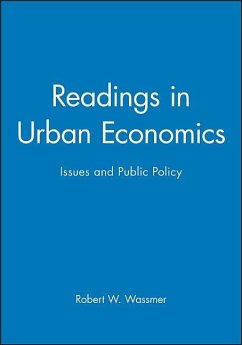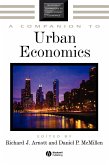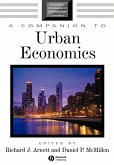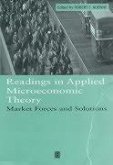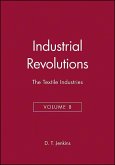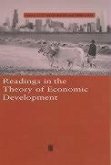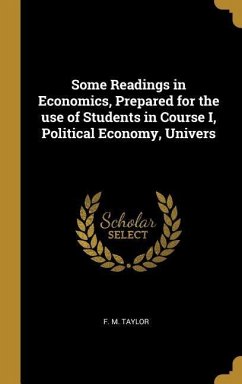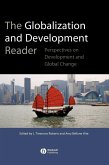Readings in Urban Economics
Issues and Public Policy
Herausgeber: Wassmer, Robert W
Readings in Urban Economics
Issues and Public Policy
Herausgeber: Wassmer, Robert W
- Gebundenes Buch
- Merkliste
- Auf die Merkliste
- Bewerten Bewerten
- Teilen
- Produkt teilen
- Produkterinnerung
- Produkterinnerung
Readings in Urban Economics: Issues and Public Policy gathers popular press articles, reviews of applied economics literature, and regression-based empirical studies to examine pressing public policy issues in urban areas. The readings extend beyond textbook economic theory and allow for a more in-depth and real-world analysis of a multitude of twenty-first-century urban concerns: * Urban growth and urban sprawl. * Housing. * Economic development incentives. * Crime. * Race, employment, and poverty. * Transportation. * Public primary and secondary education. * Local government. Advanced…mehr
Andere Kunden interessierten sich auch für
![A Companion to Urban Economics A Companion to Urban Economics]() Richard Arnott / Daniel McmillenA Companion to Urban Economics286,99 €
Richard Arnott / Daniel McmillenA Companion to Urban Economics286,99 €![Companion to Urban Economics Companion to Urban Economics]() Richard J. ArnottCompanion to Urban Economics96,99 €
Richard J. ArnottCompanion to Urban Economics96,99 €![Readings in Applied Microeconomic Theory Readings in Applied Microeconomic Theory]() Readings in Applied Microeconomic Theory207,99 €
Readings in Applied Microeconomic Theory207,99 €![The Industrial Revolutions, Volume 8 The Industrial Revolutions, Volume 8]() D T JenkinsThe Industrial Revolutions, Volume 8299,99 €
D T JenkinsThe Industrial Revolutions, Volume 8299,99 €![Readings in the Theory of Economic Development Readings in the Theory of Economic Development]() Readings in the Theory of Economic Development208,99 €
Readings in the Theory of Economic Development208,99 €![Some Readings in Economics, Prepared for the use of Students in Course I, Political Economy, Univers Some Readings in Economics, Prepared for the use of Students in Course I, Political Economy, Univers]() F. M. TaylorSome Readings in Economics, Prepared for the use of Students in Course I, Political Economy, Univers37,99 €
F. M. TaylorSome Readings in Economics, Prepared for the use of Students in Course I, Political Economy, Univers37,99 €![Globalization and Development Reader Globalization and Development Reader]() RobertsGlobalization and Development Reader170,99 €
RobertsGlobalization and Development Reader170,99 €-
-
-
Readings in Urban Economics: Issues and Public Policy gathers popular press articles, reviews of applied economics literature, and regression-based empirical studies to examine pressing public policy issues in urban areas. The readings extend beyond textbook economic theory and allow for a more in-depth and real-world analysis of a multitude of twenty-first-century urban concerns: * Urban growth and urban sprawl. * Housing. * Economic development incentives. * Crime. * Race, employment, and poverty. * Transportation. * Public primary and secondary education. * Local government. Advanced undergraduates and graduates studying urban and/or regional economics, policy, studies, affairs, and planning - as well as urban academics, practitioners, policymakers, and planners - will appreciate the editorial framework of introduction, discussion questions, samples from selected further readings, and an appendix that conveniently lists pertinent journals in applied and policy-oriented urban economics and their websites.
Hinweis: Dieser Artikel kann nur an eine deutsche Lieferadresse ausgeliefert werden.
Hinweis: Dieser Artikel kann nur an eine deutsche Lieferadresse ausgeliefert werden.
Produktdetails
- Produktdetails
- Verlag: Wiley
- Seitenzahl: 544
- Erscheinungstermin: 7. April 2000
- Englisch
- Abmessung: 251mm x 178mm x 33mm
- Gewicht: 1052g
- ISBN-13: 9780631215875
- ISBN-10: 0631215875
- Artikelnr.: 21841503
- Herstellerkennzeichnung
- Libri GmbH
- Europaallee 1
- 36244 Bad Hersfeld
- gpsr@libri.de
- Verlag: Wiley
- Seitenzahl: 544
- Erscheinungstermin: 7. April 2000
- Englisch
- Abmessung: 251mm x 178mm x 33mm
- Gewicht: 1052g
- ISBN-13: 9780631215875
- ISBN-10: 0631215875
- Artikelnr.: 21841503
- Herstellerkennzeichnung
- Libri GmbH
- Europaallee 1
- 36244 Bad Hersfeld
- gpsr@libri.de
Robert W. Wassmer is Associate Professor in the Graduate Program in Public Policy and Administration at California State University, Sacramento. As Director of the system-wide California State University Faculty Fellows Applied Research Program, he heads a group of public policy consultants to the state of California. His research in urban economic development and state/local public finance has appeared in numerous prestigious journals such as the Journal of Urban Economics and Urban Studies. He has taught at Wayne State University's Department of Economics and College of Urban, Labor, and Metropolitan Affairs, and holds a PhD from Michigan State University.
Notes on Editor and Authors.
Acknowledgments.
Part I: Introduction:.
1. Editorial Introduction: Robert W. Wassmer (Graduate Program in Public
Policy and Administration, California State University, Sacramento).
2. US Cities Coming Back from Decades of Decline: John Machacek (Writer,
Gannett News Service).
Part II: Urban Growth:.
3. The Draw of Downtown: Big Growth Predicted for Many US Cities: Dorian
Friedman (Writer, US News and World Report).
4. The State of the Cities: Downtown is Up: The Economist.
5. Urban Diversity and Economic Growth: John M. Quigley (Department of
Economics and Goldman School of Public Policy; University of California,
Berkeley).
6. Projecting Growth of Metropolitan Areas: Edwin S. Mills (Department of
Finance, Northwestern University) and Luan Sende Lubuelle (Department of
Economics, Northwestern University).
Further Reading Samples.
Discussion Questions.
Part III: Location, Land Use, and Urban Sprawl:.
7. Dreams of Fields: The New Politics of Urban Sprawl: Timothy Egan
(Writer, The New York Times).
8. Al Gore Has A New Worry: George F. Will (Newsweek).
9. Urban Spatial Structure: Alex Anas (Department of Economics, University
of Buffalo); Richard Arnott (Department of Economics, Boston College); and
Kenneth A. Small (Department of Economics, University of California,
Irvine).
10. How America's Cities are Growing: The Big Picture: Anthony Downs
(Economic Studies Program, Brookings Institution).
11. Prove It: The Costs and Benefits of Sprawl: Peter Gordon (Department of
Economics and School of Policy, Planning, and Development; University of
Southern California); and Harry W. Richardson (Department of Economics and
School of Policy, Planning, and Development, University of Southern
California).
12. Comment on Carl Abbott's 'The Portland Region: Where Cities and Suburbs
Talk to Each Other and Often Agree': William A. Fischel (Department of
Economics, Dartmouth College).
13. Do Suburbs Need Cities?: Richard Voith (Economist, Federal Reserve Bank
of Philadelphia).
Further Reading Samples.
Discussion Questions.
Part IV: Local Economic Development Incentives:.
14. Ohio Looks Hard at What's Lost Through Business Subsidies: Neal R.
Pierce (Writer, Washington Post).
15. Jobs, Productivity, and Local Economic Development: What Implications
Does Economic Research Have for the Role of Government: Timothy J. Bartik
(Economist, W. E. Upjohn Institute for Employment Research).
16. Sports, Jobs, and Taxes: Are New Stadiums Worth the Cost?: Roger G.
Noll (Department of Economics, Stanford University) and Andrew Zimbalist
(Department of Economics, Smith College).
17. Can Local Incentives Alter a Metropolitan City's Economic Development?:
Robert W. Wassmer (Graduate Program in Public Policy and Administration,
California State University, Sacramento).
Further Reading Samples.
Discussion Questions.
Part V: Race, Employment, and Poverty in Urban Areas: .
18. Big U. S. Cities Carry Welfare Burden: Deep Poverty, Isolation from
Suburbs Keep Many from Independence: Laura Meckler (Writer, Associated
Press).
19. Race Panel Divided Over Poverty: Experts Disagree on Causes, Cures of
Urban Problems: Louis Freedberg (Writer, The San Francisco Chronicle).
20. No Easy Way Out: Study Finds Urban Poverty Digs Heels In: Jamie
Woodwell (Writer, Nation's Cities Weekly) and Susan Rosenblum (Nation's
Cities Weekly).
21. Inner Cities: Edwin S. Mills (Department of Finance, Northwestern
University) and Luan Sende Lubuele (Department of Economics, Northwestern
University).
22. Information on the Spatial Distribution of Job Opportunities within
Metropolitan Areas: Keith R. Ihlanfeldt (Department of Economics, Georgia
State University).
Further Reading Samples.
Discussion Questions.
Part VI: Urban Public Education:.
23. Why I'm Reluctantly Backing Vouchers: Arthur Levine (Teachers College,
Columbia University).
24. Current Issues in Public Urban Education: Lawrence O. Picus (School of
Education, University of Southern California).
25. Why is it So Hard to Help Central City Schools?: William Duncombe
(Department of Public Administration, Syracuse University) and John Yinger
(Department of Economics, Syracuse University).
Further Reading Samples.
Discussion Questions.
Part VII: Urban Public Housing:.
26. Miracle in New Orleans: What Do a Bunch of College Professors Know
About Fixing Public Housing Projects? A Lot, it Turns Out: S. C. Gwynne
(Writer, Time Magazine).
27. Urban Housing Policy in the 1990s: Stuart A. Gabriel (Department of
Finance, University of Southern California).
28. The Dynamics of Housing Assistance Spells: Thomas L. Hungerford (United
States General Accounting Office and The American University).
Further Reading Samples.
Discussion Questions.
Part VIII: Urban Crime:.
29. The Mystery of the Falling Crime Rate: David C. Anderson (Writer, San
Diego Union-Tribune).
30. Bright Lights, Big City, and Safe Streets: Urban Dwellers Bask in
Greater Sense of Security, as Crime Rates Drop Even Further: Leon Lazaroff
(Writer, Christian Science Monitor) and Jim Blair (Writer, Christian
Science Monitor).
31. Urban Crime: Issues and Policies: Ann Dryden Witte (Department of
Economics, Florida International University).
32. Estimating the Economic Model of Crime with Panel Data: Christopher
Cornwell (Department of Economics, University of Georgia) and William
Trumbull (Department of Economics, West Virginia University).
Further Reading Samples.
Discussion Questions.
Part IX: Urban Transportation: .
33. Or, Why Motorists Always Outsmart Planners, Economists, and Traffic
Engineers: The Unbridgeable Gap: The Economist.
34. You Ride, I'll Pay: Social Benefits and Transportation Subsidies: Janet
Rothenburg Pack (Wharton School, University of Pennsylvania).
35. Urban Traffic Congestion: A New Approach to the Gordian Knot: Kenneth
A. Small (Department of Economics, University of California, Irvine).
36. Infrastructure Services and the Productivity of Public Capital: The
Case of Streets and Highways: Marlon G. Boarnet (Department of Urban and
Regional Planning, University of California, Irvine).
Further Reading Samples.
Discussion Questions.
Part X: Local Government:.
37. Why I Love the Suburbs: Debra Meyers (Citizen Editorialist, Buffalo
News).
38. Metropolitan Fiscal Disparities: Roy Bahl (Department of Economics,
Georgia State University).
39. Economic Influences on the Structure of Local Government in US
Metropolitan Areas: Ronald C. Fisher (Department of Economics and Honors
College, Michigan State University) and Robert W. Wassmer (Graduate Program
in Public Policy and Administration, California State University,
Sacramento).
Further Reading Samples.
Discussion Questions.
Appendix: Academic Journals and Websites in Applied and Policy-Orientated
Urban Economics.
Index.
Acknowledgments.
Part I: Introduction:.
1. Editorial Introduction: Robert W. Wassmer (Graduate Program in Public
Policy and Administration, California State University, Sacramento).
2. US Cities Coming Back from Decades of Decline: John Machacek (Writer,
Gannett News Service).
Part II: Urban Growth:.
3. The Draw of Downtown: Big Growth Predicted for Many US Cities: Dorian
Friedman (Writer, US News and World Report).
4. The State of the Cities: Downtown is Up: The Economist.
5. Urban Diversity and Economic Growth: John M. Quigley (Department of
Economics and Goldman School of Public Policy; University of California,
Berkeley).
6. Projecting Growth of Metropolitan Areas: Edwin S. Mills (Department of
Finance, Northwestern University) and Luan Sende Lubuelle (Department of
Economics, Northwestern University).
Further Reading Samples.
Discussion Questions.
Part III: Location, Land Use, and Urban Sprawl:.
7. Dreams of Fields: The New Politics of Urban Sprawl: Timothy Egan
(Writer, The New York Times).
8. Al Gore Has A New Worry: George F. Will (Newsweek).
9. Urban Spatial Structure: Alex Anas (Department of Economics, University
of Buffalo); Richard Arnott (Department of Economics, Boston College); and
Kenneth A. Small (Department of Economics, University of California,
Irvine).
10. How America's Cities are Growing: The Big Picture: Anthony Downs
(Economic Studies Program, Brookings Institution).
11. Prove It: The Costs and Benefits of Sprawl: Peter Gordon (Department of
Economics and School of Policy, Planning, and Development; University of
Southern California); and Harry W. Richardson (Department of Economics and
School of Policy, Planning, and Development, University of Southern
California).
12. Comment on Carl Abbott's 'The Portland Region: Where Cities and Suburbs
Talk to Each Other and Often Agree': William A. Fischel (Department of
Economics, Dartmouth College).
13. Do Suburbs Need Cities?: Richard Voith (Economist, Federal Reserve Bank
of Philadelphia).
Further Reading Samples.
Discussion Questions.
Part IV: Local Economic Development Incentives:.
14. Ohio Looks Hard at What's Lost Through Business Subsidies: Neal R.
Pierce (Writer, Washington Post).
15. Jobs, Productivity, and Local Economic Development: What Implications
Does Economic Research Have for the Role of Government: Timothy J. Bartik
(Economist, W. E. Upjohn Institute for Employment Research).
16. Sports, Jobs, and Taxes: Are New Stadiums Worth the Cost?: Roger G.
Noll (Department of Economics, Stanford University) and Andrew Zimbalist
(Department of Economics, Smith College).
17. Can Local Incentives Alter a Metropolitan City's Economic Development?:
Robert W. Wassmer (Graduate Program in Public Policy and Administration,
California State University, Sacramento).
Further Reading Samples.
Discussion Questions.
Part V: Race, Employment, and Poverty in Urban Areas: .
18. Big U. S. Cities Carry Welfare Burden: Deep Poverty, Isolation from
Suburbs Keep Many from Independence: Laura Meckler (Writer, Associated
Press).
19. Race Panel Divided Over Poverty: Experts Disagree on Causes, Cures of
Urban Problems: Louis Freedberg (Writer, The San Francisco Chronicle).
20. No Easy Way Out: Study Finds Urban Poverty Digs Heels In: Jamie
Woodwell (Writer, Nation's Cities Weekly) and Susan Rosenblum (Nation's
Cities Weekly).
21. Inner Cities: Edwin S. Mills (Department of Finance, Northwestern
University) and Luan Sende Lubuele (Department of Economics, Northwestern
University).
22. Information on the Spatial Distribution of Job Opportunities within
Metropolitan Areas: Keith R. Ihlanfeldt (Department of Economics, Georgia
State University).
Further Reading Samples.
Discussion Questions.
Part VI: Urban Public Education:.
23. Why I'm Reluctantly Backing Vouchers: Arthur Levine (Teachers College,
Columbia University).
24. Current Issues in Public Urban Education: Lawrence O. Picus (School of
Education, University of Southern California).
25. Why is it So Hard to Help Central City Schools?: William Duncombe
(Department of Public Administration, Syracuse University) and John Yinger
(Department of Economics, Syracuse University).
Further Reading Samples.
Discussion Questions.
Part VII: Urban Public Housing:.
26. Miracle in New Orleans: What Do a Bunch of College Professors Know
About Fixing Public Housing Projects? A Lot, it Turns Out: S. C. Gwynne
(Writer, Time Magazine).
27. Urban Housing Policy in the 1990s: Stuart A. Gabriel (Department of
Finance, University of Southern California).
28. The Dynamics of Housing Assistance Spells: Thomas L. Hungerford (United
States General Accounting Office and The American University).
Further Reading Samples.
Discussion Questions.
Part VIII: Urban Crime:.
29. The Mystery of the Falling Crime Rate: David C. Anderson (Writer, San
Diego Union-Tribune).
30. Bright Lights, Big City, and Safe Streets: Urban Dwellers Bask in
Greater Sense of Security, as Crime Rates Drop Even Further: Leon Lazaroff
(Writer, Christian Science Monitor) and Jim Blair (Writer, Christian
Science Monitor).
31. Urban Crime: Issues and Policies: Ann Dryden Witte (Department of
Economics, Florida International University).
32. Estimating the Economic Model of Crime with Panel Data: Christopher
Cornwell (Department of Economics, University of Georgia) and William
Trumbull (Department of Economics, West Virginia University).
Further Reading Samples.
Discussion Questions.
Part IX: Urban Transportation: .
33. Or, Why Motorists Always Outsmart Planners, Economists, and Traffic
Engineers: The Unbridgeable Gap: The Economist.
34. You Ride, I'll Pay: Social Benefits and Transportation Subsidies: Janet
Rothenburg Pack (Wharton School, University of Pennsylvania).
35. Urban Traffic Congestion: A New Approach to the Gordian Knot: Kenneth
A. Small (Department of Economics, University of California, Irvine).
36. Infrastructure Services and the Productivity of Public Capital: The
Case of Streets and Highways: Marlon G. Boarnet (Department of Urban and
Regional Planning, University of California, Irvine).
Further Reading Samples.
Discussion Questions.
Part X: Local Government:.
37. Why I Love the Suburbs: Debra Meyers (Citizen Editorialist, Buffalo
News).
38. Metropolitan Fiscal Disparities: Roy Bahl (Department of Economics,
Georgia State University).
39. Economic Influences on the Structure of Local Government in US
Metropolitan Areas: Ronald C. Fisher (Department of Economics and Honors
College, Michigan State University) and Robert W. Wassmer (Graduate Program
in Public Policy and Administration, California State University,
Sacramento).
Further Reading Samples.
Discussion Questions.
Appendix: Academic Journals and Websites in Applied and Policy-Orientated
Urban Economics.
Index.
Notes on Editor and Authors.
Acknowledgments.
Part I: Introduction:.
1. Editorial Introduction: Robert W. Wassmer (Graduate Program in Public
Policy and Administration, California State University, Sacramento).
2. US Cities Coming Back from Decades of Decline: John Machacek (Writer,
Gannett News Service).
Part II: Urban Growth:.
3. The Draw of Downtown: Big Growth Predicted for Many US Cities: Dorian
Friedman (Writer, US News and World Report).
4. The State of the Cities: Downtown is Up: The Economist.
5. Urban Diversity and Economic Growth: John M. Quigley (Department of
Economics and Goldman School of Public Policy; University of California,
Berkeley).
6. Projecting Growth of Metropolitan Areas: Edwin S. Mills (Department of
Finance, Northwestern University) and Luan Sende Lubuelle (Department of
Economics, Northwestern University).
Further Reading Samples.
Discussion Questions.
Part III: Location, Land Use, and Urban Sprawl:.
7. Dreams of Fields: The New Politics of Urban Sprawl: Timothy Egan
(Writer, The New York Times).
8. Al Gore Has A New Worry: George F. Will (Newsweek).
9. Urban Spatial Structure: Alex Anas (Department of Economics, University
of Buffalo); Richard Arnott (Department of Economics, Boston College); and
Kenneth A. Small (Department of Economics, University of California,
Irvine).
10. How America's Cities are Growing: The Big Picture: Anthony Downs
(Economic Studies Program, Brookings Institution).
11. Prove It: The Costs and Benefits of Sprawl: Peter Gordon (Department of
Economics and School of Policy, Planning, and Development; University of
Southern California); and Harry W. Richardson (Department of Economics and
School of Policy, Planning, and Development, University of Southern
California).
12. Comment on Carl Abbott's 'The Portland Region: Where Cities and Suburbs
Talk to Each Other and Often Agree': William A. Fischel (Department of
Economics, Dartmouth College).
13. Do Suburbs Need Cities?: Richard Voith (Economist, Federal Reserve Bank
of Philadelphia).
Further Reading Samples.
Discussion Questions.
Part IV: Local Economic Development Incentives:.
14. Ohio Looks Hard at What's Lost Through Business Subsidies: Neal R.
Pierce (Writer, Washington Post).
15. Jobs, Productivity, and Local Economic Development: What Implications
Does Economic Research Have for the Role of Government: Timothy J. Bartik
(Economist, W. E. Upjohn Institute for Employment Research).
16. Sports, Jobs, and Taxes: Are New Stadiums Worth the Cost?: Roger G.
Noll (Department of Economics, Stanford University) and Andrew Zimbalist
(Department of Economics, Smith College).
17. Can Local Incentives Alter a Metropolitan City's Economic Development?:
Robert W. Wassmer (Graduate Program in Public Policy and Administration,
California State University, Sacramento).
Further Reading Samples.
Discussion Questions.
Part V: Race, Employment, and Poverty in Urban Areas: .
18. Big U. S. Cities Carry Welfare Burden: Deep Poverty, Isolation from
Suburbs Keep Many from Independence: Laura Meckler (Writer, Associated
Press).
19. Race Panel Divided Over Poverty: Experts Disagree on Causes, Cures of
Urban Problems: Louis Freedberg (Writer, The San Francisco Chronicle).
20. No Easy Way Out: Study Finds Urban Poverty Digs Heels In: Jamie
Woodwell (Writer, Nation's Cities Weekly) and Susan Rosenblum (Nation's
Cities Weekly).
21. Inner Cities: Edwin S. Mills (Department of Finance, Northwestern
University) and Luan Sende Lubuele (Department of Economics, Northwestern
University).
22. Information on the Spatial Distribution of Job Opportunities within
Metropolitan Areas: Keith R. Ihlanfeldt (Department of Economics, Georgia
State University).
Further Reading Samples.
Discussion Questions.
Part VI: Urban Public Education:.
23. Why I'm Reluctantly Backing Vouchers: Arthur Levine (Teachers College,
Columbia University).
24. Current Issues in Public Urban Education: Lawrence O. Picus (School of
Education, University of Southern California).
25. Why is it So Hard to Help Central City Schools?: William Duncombe
(Department of Public Administration, Syracuse University) and John Yinger
(Department of Economics, Syracuse University).
Further Reading Samples.
Discussion Questions.
Part VII: Urban Public Housing:.
26. Miracle in New Orleans: What Do a Bunch of College Professors Know
About Fixing Public Housing Projects? A Lot, it Turns Out: S. C. Gwynne
(Writer, Time Magazine).
27. Urban Housing Policy in the 1990s: Stuart A. Gabriel (Department of
Finance, University of Southern California).
28. The Dynamics of Housing Assistance Spells: Thomas L. Hungerford (United
States General Accounting Office and The American University).
Further Reading Samples.
Discussion Questions.
Part VIII: Urban Crime:.
29. The Mystery of the Falling Crime Rate: David C. Anderson (Writer, San
Diego Union-Tribune).
30. Bright Lights, Big City, and Safe Streets: Urban Dwellers Bask in
Greater Sense of Security, as Crime Rates Drop Even Further: Leon Lazaroff
(Writer, Christian Science Monitor) and Jim Blair (Writer, Christian
Science Monitor).
31. Urban Crime: Issues and Policies: Ann Dryden Witte (Department of
Economics, Florida International University).
32. Estimating the Economic Model of Crime with Panel Data: Christopher
Cornwell (Department of Economics, University of Georgia) and William
Trumbull (Department of Economics, West Virginia University).
Further Reading Samples.
Discussion Questions.
Part IX: Urban Transportation: .
33. Or, Why Motorists Always Outsmart Planners, Economists, and Traffic
Engineers: The Unbridgeable Gap: The Economist.
34. You Ride, I'll Pay: Social Benefits and Transportation Subsidies: Janet
Rothenburg Pack (Wharton School, University of Pennsylvania).
35. Urban Traffic Congestion: A New Approach to the Gordian Knot: Kenneth
A. Small (Department of Economics, University of California, Irvine).
36. Infrastructure Services and the Productivity of Public Capital: The
Case of Streets and Highways: Marlon G. Boarnet (Department of Urban and
Regional Planning, University of California, Irvine).
Further Reading Samples.
Discussion Questions.
Part X: Local Government:.
37. Why I Love the Suburbs: Debra Meyers (Citizen Editorialist, Buffalo
News).
38. Metropolitan Fiscal Disparities: Roy Bahl (Department of Economics,
Georgia State University).
39. Economic Influences on the Structure of Local Government in US
Metropolitan Areas: Ronald C. Fisher (Department of Economics and Honors
College, Michigan State University) and Robert W. Wassmer (Graduate Program
in Public Policy and Administration, California State University,
Sacramento).
Further Reading Samples.
Discussion Questions.
Appendix: Academic Journals and Websites in Applied and Policy-Orientated
Urban Economics.
Index.
Acknowledgments.
Part I: Introduction:.
1. Editorial Introduction: Robert W. Wassmer (Graduate Program in Public
Policy and Administration, California State University, Sacramento).
2. US Cities Coming Back from Decades of Decline: John Machacek (Writer,
Gannett News Service).
Part II: Urban Growth:.
3. The Draw of Downtown: Big Growth Predicted for Many US Cities: Dorian
Friedman (Writer, US News and World Report).
4. The State of the Cities: Downtown is Up: The Economist.
5. Urban Diversity and Economic Growth: John M. Quigley (Department of
Economics and Goldman School of Public Policy; University of California,
Berkeley).
6. Projecting Growth of Metropolitan Areas: Edwin S. Mills (Department of
Finance, Northwestern University) and Luan Sende Lubuelle (Department of
Economics, Northwestern University).
Further Reading Samples.
Discussion Questions.
Part III: Location, Land Use, and Urban Sprawl:.
7. Dreams of Fields: The New Politics of Urban Sprawl: Timothy Egan
(Writer, The New York Times).
8. Al Gore Has A New Worry: George F. Will (Newsweek).
9. Urban Spatial Structure: Alex Anas (Department of Economics, University
of Buffalo); Richard Arnott (Department of Economics, Boston College); and
Kenneth A. Small (Department of Economics, University of California,
Irvine).
10. How America's Cities are Growing: The Big Picture: Anthony Downs
(Economic Studies Program, Brookings Institution).
11. Prove It: The Costs and Benefits of Sprawl: Peter Gordon (Department of
Economics and School of Policy, Planning, and Development; University of
Southern California); and Harry W. Richardson (Department of Economics and
School of Policy, Planning, and Development, University of Southern
California).
12. Comment on Carl Abbott's 'The Portland Region: Where Cities and Suburbs
Talk to Each Other and Often Agree': William A. Fischel (Department of
Economics, Dartmouth College).
13. Do Suburbs Need Cities?: Richard Voith (Economist, Federal Reserve Bank
of Philadelphia).
Further Reading Samples.
Discussion Questions.
Part IV: Local Economic Development Incentives:.
14. Ohio Looks Hard at What's Lost Through Business Subsidies: Neal R.
Pierce (Writer, Washington Post).
15. Jobs, Productivity, and Local Economic Development: What Implications
Does Economic Research Have for the Role of Government: Timothy J. Bartik
(Economist, W. E. Upjohn Institute for Employment Research).
16. Sports, Jobs, and Taxes: Are New Stadiums Worth the Cost?: Roger G.
Noll (Department of Economics, Stanford University) and Andrew Zimbalist
(Department of Economics, Smith College).
17. Can Local Incentives Alter a Metropolitan City's Economic Development?:
Robert W. Wassmer (Graduate Program in Public Policy and Administration,
California State University, Sacramento).
Further Reading Samples.
Discussion Questions.
Part V: Race, Employment, and Poverty in Urban Areas: .
18. Big U. S. Cities Carry Welfare Burden: Deep Poverty, Isolation from
Suburbs Keep Many from Independence: Laura Meckler (Writer, Associated
Press).
19. Race Panel Divided Over Poverty: Experts Disagree on Causes, Cures of
Urban Problems: Louis Freedberg (Writer, The San Francisco Chronicle).
20. No Easy Way Out: Study Finds Urban Poverty Digs Heels In: Jamie
Woodwell (Writer, Nation's Cities Weekly) and Susan Rosenblum (Nation's
Cities Weekly).
21. Inner Cities: Edwin S. Mills (Department of Finance, Northwestern
University) and Luan Sende Lubuele (Department of Economics, Northwestern
University).
22. Information on the Spatial Distribution of Job Opportunities within
Metropolitan Areas: Keith R. Ihlanfeldt (Department of Economics, Georgia
State University).
Further Reading Samples.
Discussion Questions.
Part VI: Urban Public Education:.
23. Why I'm Reluctantly Backing Vouchers: Arthur Levine (Teachers College,
Columbia University).
24. Current Issues in Public Urban Education: Lawrence O. Picus (School of
Education, University of Southern California).
25. Why is it So Hard to Help Central City Schools?: William Duncombe
(Department of Public Administration, Syracuse University) and John Yinger
(Department of Economics, Syracuse University).
Further Reading Samples.
Discussion Questions.
Part VII: Urban Public Housing:.
26. Miracle in New Orleans: What Do a Bunch of College Professors Know
About Fixing Public Housing Projects? A Lot, it Turns Out: S. C. Gwynne
(Writer, Time Magazine).
27. Urban Housing Policy in the 1990s: Stuart A. Gabriel (Department of
Finance, University of Southern California).
28. The Dynamics of Housing Assistance Spells: Thomas L. Hungerford (United
States General Accounting Office and The American University).
Further Reading Samples.
Discussion Questions.
Part VIII: Urban Crime:.
29. The Mystery of the Falling Crime Rate: David C. Anderson (Writer, San
Diego Union-Tribune).
30. Bright Lights, Big City, and Safe Streets: Urban Dwellers Bask in
Greater Sense of Security, as Crime Rates Drop Even Further: Leon Lazaroff
(Writer, Christian Science Monitor) and Jim Blair (Writer, Christian
Science Monitor).
31. Urban Crime: Issues and Policies: Ann Dryden Witte (Department of
Economics, Florida International University).
32. Estimating the Economic Model of Crime with Panel Data: Christopher
Cornwell (Department of Economics, University of Georgia) and William
Trumbull (Department of Economics, West Virginia University).
Further Reading Samples.
Discussion Questions.
Part IX: Urban Transportation: .
33. Or, Why Motorists Always Outsmart Planners, Economists, and Traffic
Engineers: The Unbridgeable Gap: The Economist.
34. You Ride, I'll Pay: Social Benefits and Transportation Subsidies: Janet
Rothenburg Pack (Wharton School, University of Pennsylvania).
35. Urban Traffic Congestion: A New Approach to the Gordian Knot: Kenneth
A. Small (Department of Economics, University of California, Irvine).
36. Infrastructure Services and the Productivity of Public Capital: The
Case of Streets and Highways: Marlon G. Boarnet (Department of Urban and
Regional Planning, University of California, Irvine).
Further Reading Samples.
Discussion Questions.
Part X: Local Government:.
37. Why I Love the Suburbs: Debra Meyers (Citizen Editorialist, Buffalo
News).
38. Metropolitan Fiscal Disparities: Roy Bahl (Department of Economics,
Georgia State University).
39. Economic Influences on the Structure of Local Government in US
Metropolitan Areas: Ronald C. Fisher (Department of Economics and Honors
College, Michigan State University) and Robert W. Wassmer (Graduate Program
in Public Policy and Administration, California State University,
Sacramento).
Further Reading Samples.
Discussion Questions.
Appendix: Academic Journals and Websites in Applied and Policy-Orientated
Urban Economics.
Index.

